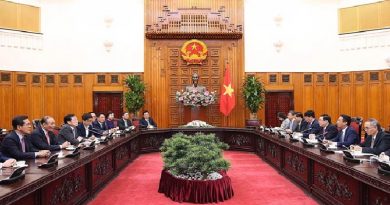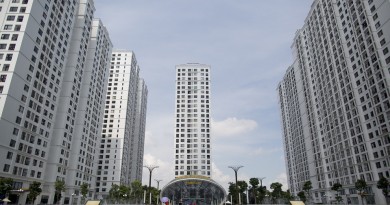Facts and figures: Free Trade Agreement between EU and Vietnam
Yesterday, EU Trade Commissioner Cecilia Malmström and Vietnamese Minister of Industry and Trade Vu Huy Hoang agreed in principle on a comprehensive and ambitious trade and investment agreement. The final legal texts will have to be ironed out by negotiators after the summer break, but the substance of the deal has been agreed. This Free Trade Agreement (FTA), for which negotiations started in October 2012, is the most ambitious and comprehensive FTA that the EU has ever concluded with a developing country, the second in the ASEAN region after Singapore, and a further building block towards the EU’s ultimate objective of an ambitious and comprehensive region-to-region EU-ASEAN FTA. This agreement will allow EU exporters and investors to access a fast-growing market of 90 million people and to consolidate their presence in one of the most dynamic regions in the world.
Facts and figures: Free Trade Agreement between EU and Vietnam
On 4 August, EU Trade Commissioner Cecilia Malmström and Vietnamese Minister of Industry and Trade Vu Huy Hoang agreed in principle on a comprehensive and ambitious trade and investment agreement. The final legal texts will have to be ironed out by negotiators after the summer break, but the substance of the deal has been agreed. This Free Trade Agreement (FTA), for which negotiations started in October 2012, is the most ambitious and comprehensive FTA that the EU has ever concluded with a developing country, the second in the ASEAN region after Singapore, and a further building block towards the EU’s ultimate objective of an ambitious and comprehensive region-to-region EU-ASEAN FTA. This agreement will allow EU exporters and investors to access a fast-growing market of 90 million people and to consolidate their presence in one of the most dynamic regions in the world.
What the EU-Vietnam FTA is about
1 – Eliminating customs duties
The EU-Vietnam FTA willeliminate nearly all tariffs (over 99%), except for a small number of tariff lines for which the EU and Vietnam agreed on partial liberalisation through zero-duty Tariff Rate Quotas (TRQs):
- Vietnam will liberalise 65% of import duties on EU exports to Vietnam at entry into force, with the remainder of duties being gradually eliminated over a 10-year period.
- EU duties will be eliminated over a 7-year period.
This is a far-reaching, fully symmetrical tariff elimination that has never before been achieved with a developing country, but with adequate transition periods to allow Vietnam to adapt.
A few concrete examples:
- Almost all EU exports of machinery and appliances will be fully liberalised at entry into force and the rest after 5 years.
- Motorcycles with engines larger than 150 cc will be liberalised after 7 years and cars after 10 years, except those with large engines (>3000cc for petrol, > 2500cc for diesel) which will be liberalised one year earlier.
- Car parts will be duty free after 7 years. Roughly half of EU pharmaceuticals exports will be duty free at entry into force and the rest after 7 years.
- The totality of EU textile fabric exports will be liberalised at entry into force.
- Close to 70% of EU chemicals export will be duty free at entry into force and the rest after 3, 5 and 7 years.
Vietnam will also open its market for most EU food products, both primary and processed, allowing EU high quality exports to reach its growing middle class consumers.
- Wines and spirits will be liberalised after 7 years.
- Frozen pork meat will be duty free after 7 years, beef after 3 years, dairy products after a maximum of 5 years and food preparations after a maximum of 7 years.
- Chicken will be fully liberalised after 10 years.
The EU will also eliminate duties with longer staging periods (up to 7 years) for some sensitive products, especially in the textile apparel and footwear sectors. The elimination of duties, however, will not be an open door for Chinese products to flood the EU market: to benefit from the preferential access, the strict rules of origin for garments will require the use of fabrics produced in Vietnam, with the only exception being of fabrics produced in South Korea, another FTA partner of the EU.
Only some sensitive agricultural products will not be fully liberalised, but the EU has offered access to Vietnamese exports via tariff rate quotas (TRQs): rice, sweet corn, garlic, mushrooms, sugar and high-sugar-containing products, manioc starch, surimi and canned tuna.
Besides eliminating tariffs, Vietnam will also remove almost all its export duties in its bilateral trade with the EU, and has agreed not to increase a few that will exceptionally remain in force.
2 – Reducing non-tariff barriers to European exports
The EU and Vietnam have agreed to strengthen the disciplines of the WTO Technical Barriers to Trade (TBT) agreement. In particular, Vietnam has committed to increasing the use of international standards in drafting its regulations. The agreement also contains a chapter addressing Sanitary and Phytosanitary measures (SPS), specifically aimed at facilitating trade in plant and animal products, where the parties agreed on some important principles such as regionalization and the recognition of the EU as a single entity. These provisions will facilitate access for EU companies producing a large variety of products, including electrical appliances, IT, and food and drinks to the Vietnamese market.
The agreement will also contain a specific annex with far-reaching provisions to address non-tariff barriers in the automotive sector, including, five years after its entry into force, the recognition of the EU vehicle whole certificate of conformity.
Also for the first time in an FTA, Vietnam accepted the marking of origin “Made in EU” for non-agricultural goods, with the exception of pharmaceuticals (which are still to a great extent subject to national approvals in the EU). Member State-specific markings of origin will continue to be accepted as well. This provision will allow manufacturers to reflect the increasing EU market integration.
All these provisions, together with others addressing, for example, import and export licensing, customs procedures, trade in plant and animal products, will facilitate access of European goods to the Vietnamese market and boost their competitiveness vis-à-vis other suppliers.
3 – Protecting European Geographical Indications
Farmers and small businesses producing food with traditional methods will benefit from the recognition and protection on the Vietnamese market – at a comparable level to that of EU legislation – of 169 European food and drink products from a specific geographical origin. This means that the use of Geographical indications (GIs) such as Champagne, Parmigiano Reggiano cheese, Rioja wine, Roquefort cheese or Scotch Whisky will be reserved in Vietnam for products imported from the European regions where they traditionally come from.
Vietnamese GIs too will be recognised as such in the EU, providing the adequate framework for further promoting imports of quality products such as Mộc Châu tea or Buôn Ma Thuột coffee.
The agreement will allow new GIs to be added in the future.
4 – Allowing EU companies to bid for Vietnamese public contracts
With this agreement EU companies will be able to bid for public contracts with:
- Vietnamese ministries, including for infrastructure such as roads and ports
- important state-owned enterprises such as the power distribution company and the nationwide railway operator
- 34 public hospitals
- the two biggest Vietnamese cities, Hanoi and Ho Chi Min City
The EU and Vietnam have also agreed on disciplines fully in line with Government Procurement Agreement (GPA) rules, achieving a degree of transparency and procedural fairness comparable to other EU FTAs with developed countries and more advanced developing countries. EU businesses will be the first foreign companies to get such a level of access to Vietnamese procurement markets.
5 – Creating a level playing field for EU companies and innovative products
With the disciplines agreed on State Owned Enterprises (SOEs) and subsidies, the EU-Vietnam FTA will level the playing field between SOEs and private enterprises when SOEs are engaged in commercial activities. There will also be rules on transparency and consultations on domestic subsidies. These are the most ambitious disciplines that Vietnam has ever agreed to.
On Intellectual Property Rights, Vietnam has committed to a high level of protection, going beyond the standards of WTO TRIPs agreement. With this agreement, EU innovations, artworks and brands will be better protected against being unlawfully copied, including through stronger enforcement provisions.
Among others, the EU pharmaceutical sector will benefit from improved data protection and of the possibility to get an extension of the patent up to two years if there are delays in the marketing authorization. In a specific annex on pharmaceutical products, the Parties have agreed to a set of other provisions facilitating trade in these products, which are of great importance in the EU-Vietnam trade (second export item, amounting to about 9% of total EU exports to Vietnam). Vietnam has also taken commitments concerning procurement of pharmaceutical products and has allowed foreign-invested companies to import and sell medicines to distributors and wholesalers within the country.
6 – Opening the Vietnamese market for EU services operators
Vietnam has committed to substantially improve access for EU companies to a broad range of services sectors, including:
- business services
- environmental services
- postal and courier services
- banking
- insurance
- maritime transport
It has also accepted a set of regulatory disciplines in key sectors such as financial services, telecommunications, maritime transport and postal services. The result of this chapter goes largely beyond both WTO commitments and any other FTA that Vietnam has concluded, thereby giving EU companies the best possible access to the Vietnamese market. Moreover, the agreement will contain a clause allowing the best results of FTAs being negotiated at the moment to be incorporated in the EU-Vietnam FTA.
7 – Promoting and protecting investment
Vietnam has committed to open up to investments in manufacturing in a number of key sectors:
- food products and beverages
- fertilisers and nitrogen composites
- tyres and tubes
- gloves and plastic products
- ceramics
- construction materials
On machinery, Vietnam removed restrictions on the assembly of marine engines and agricultural machinery, domestic appliances and on bicycles. It also improved the commitments for recycling.
On investment protection, both sides have already achieved a lot, including an agreement on key provisions on protection such as National Treatment and understandings on the main substantive investment protection rules.
Provisions on investment protection and dispute settlement are still being negotiated in light of the new EU approach on investment dispute settlement.
8 – Establishing an efficient mechanism to resolve future disagreements
The FTA creates a framework to resolve any future disagreements that may occur between EU and Vietnam about the interpretation and implementation of the agreement. It applies to most areas of the agreement and it is faster and more efficient in many aspects than the dispute settlement mechanism in the WTO. The system is intended as a last resort should the Parties fail to find a solution by other means. It proceeds along a fixed set of procedures and time-frames. Should Parties fail to reach an agreement through formal consultations, they can request the establishment of a panel, made up of independent legal experts.
As an alternative to a formal dispute settlement mechanism, the EU and Vietnam also set rules that will allow for mediation to tackle measures that adversely affect bilateral trade and investment. This can be used on a voluntary basis, and reflect the preference of the EU and Vietnam for the fast, amicable solution of potential disputes whenever possible.
9 – Safeguarding social and environmental protection standards
The EU and Vietnam have agreed on a robust and comprehensive chapter on trade and sustainable development, with an extensive list of commitments including:
- Commitment to the effective implementation by each Party of the ILO core labour standards, ratified ILO Conventions (not only the fundamental ones) and ratified Multilateral Environmental Agreements and to ratification of not yet ratified fundamental ILO Conventions.
- Obligations not to derogate from and to effectively enforce domestic labour and environmental laws to attract trade and investment – in other words prohibition of social and environmental dumping.
- Promotion of Corporate Social Responsibility, including references to international instruments in this regard.
- A dedicated article on climate change and commitments to the conservation and sustainable management of biodiversity (including wildlife), forestry (including illegal logging), and fisheries.
- Mechanisms for the involvement of civil society in the implementation of the chapter, both by each side domestically (consultation of “domestic advisory groups”) and by the EU and Vietnam jointly (meetings of a “joint forum”), and several provisions enhancing transparency and accountability
10 – Promoting democracy and respect for human rights
In the preamble of the FTA the Parties reaffirm their commitment to the Charter of the United Nations signed in San Francisco on 26 June 1945 and have regard to the principles articulated in The Universal Declaration of Human Rights adopted by the General Assembly of the United Nations on 10 December 1948.
The FTA will also contain a legally binding link with the EU-Vietnam Partnership and Cooperation Agreement (PCA), signed in June 2012, which includes a human rights clause and provisions on cooperation on human rights. The PCA provides that human rights, democracy, and the rule of law are ‘essential elements’ in the overall relationship between the EU and Vietnam. Therefore, the link between the FTA and the PCA is important to ensure that human rights are also part of the trade relationship between the Parties. This would include the right to take appropriate measures, also in relation to the FTA (including its suspension), in case of major violations of these essential elements.
The agreement also includes a chapter on cooperation, as a means to contribute to the efficient implementation of the FTA. Boosting sustainable development in all its dimensions is a key objective for such cooperation, for which areas of particular importance include labour and environmental matters, trade facilitation, and SMEs. This chapter is placed under the existing EU-Vietnam Framework Cooperation Agreement (FCA).
Future cooperation will build on the successful experience of the EU flagship cooperation programme with Vietnam (MUTRAP), which aims at supporting Vietnam in facilitating sustainable international trade and investment through improved capacity for policy making, policy consultation, and the negotiation and implementation of related commitments, particularly as regards the EU.
Source: Europa.eu







